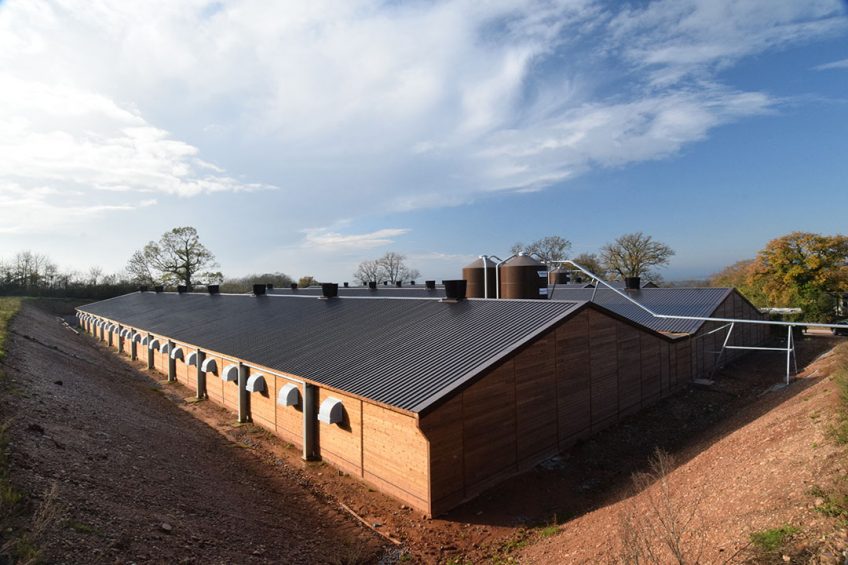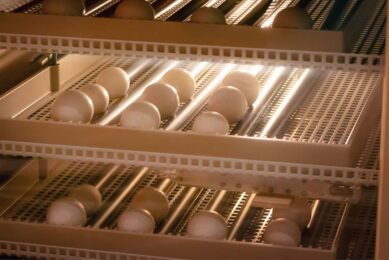High-tech broiler breeder units drive business forward

DraperLAYERS organised a number of open days at a new broiler breeder unit on the outskirts of Exeter ahead of the first birds coming in at the end of December. Tony McDougal reports from Devon.
Moves to enable the next generation to enter the family business has prompted broiler breeder Jerry Frankpitt to expand production in the heart of east Devon.
Mr Frankpitt already has a 48,000-bird broiler breeder unit, which was built in two stages – the first completed in February 2000 and the second in June 2006.
He has been supplying Faccenda (now Avara Group) with Ross 308 hatching eggs for its hatchery on the outskirts of Southampton.
Chick quality
“Ultimately our aim is to provide good viable chicks for the broiler sector. Biosecurity is absolutely crucial given the multiplication factor involved in our business. If we can’t get it to work it leads to massive problems down the way,” he said.
As an independent broiler breeder specialist, Mr Frankpitt said close attention to detail was vital: “The management is a lot more intensive. We will run this new unit with three full time staff and run the other one with four to five staff.” Labour is local and there are no issues getting good staff.
His son Alex, who has been working for Avara Foods, will run the business with him, ably helped by daughter Holly, who looks after the office.
It has been quite a journey for Mr Frankpitt, who is a trained geologist and worked in Australia until the mid-1990s before returning to the South West. But the family have been involved in poultry since the 1950s; first with layers and then in broilers and finally broiler breeders.
“We decided we wanted to expand the business for Alex and the children. Originally, we were looking to build it with Faccenda but Annyalla Chicks said they wanted us to build a farm for them.
“John Mawer asked us in the spring to build one and have it ready for next spring. We have been fortunate with the dry summer which has allowed us to get on with the four poultry houses, which has capacity for 36,000 hens.”
Mr Frankpitt said it was important for biosecurity that the trapezoid poultry houses were interconnected: “We have two here and two angled further up the hill.”
Pullets
The birds arrive from a specialist rearing farm near Salisbury at 18 weeks and start producing their first eggs at 21 weeks, reaching a peak at between 28-29 weeks when the laying percentage is around 85%. Each bird will lay about 140 hatching eggs for the next 32 weeks, taking them to 60 weeks before depletion. The spent hens then go into the meat chain export market, often to France or Poland.
Once in, the birds are fed exact measured rations from four Collinson Silos – two per pair of poultry houses: “Good feed distribution is vital. Birds received exact measure rations – not fed ad-lib.”
The specific broiler breeder soya/wheat ration comes from leading feed manufacturer, Winchester-based Humphrey Feeds and Pullets. Mr Frankpitt is proud to be introducing the first draperLAYERS Landmeco broiler breeder feeding system and breeder nest to the UK, believing it to have a number of benefits. For male feeding, it allows rapid feed distribution along the line, ensuring there is simultaneous feeding of all males. For female feeding all troughs are filled before they are lowered.
The spacious laying nest ensures clean eggs and is extremely easy to clean: “It’s quite a novel laying arrangement and provides 25% more laying space for the hens.”
Ventilation has been installed by Draper Ventilation and Mr Frankpitt is using the Dutch company Hotraco Agri and its sophisticated Fortica control system.

Climate control
Emma Mingo, draperCARE poultry consultant said the Fortica system controls the atmosphere and the environment, keeping tabs on humidity, temperature and carbon dioxide levels.
She said it was important to keep temperatures constant as there was evidence that colder air had a detrimental effect on egg production, potentially squeezing already tight margins.
Water is pumped into the site and is constantly sanitised using low levels of hypochlorite to ensure that excellent gut and bird health is maintained. Dirty water is exported off site.
The units have a LED globe lighting system, which allows 360 degree light pattern and even distribution across the sheds. Lighting is fairly dim (10-20 lux) when the birds first arrive on site but levels are increased as they come into maturity.
The four broiler breeder houses have been built by Harlow Bros. Sales manager Tom Simpson said the company had received a very clear brief: “We had to meet a stringent specification because broiler breeders need to be high on biosecurity, especially around the ceiling and insulation.
“Each pair of houses took us four weeks so the job was completed in eight weeks within the ten-week period set,” he said.
Insulation is really vital to maintain a constant temperature for the birds. No additional heating is used but the Frankpitt family is looking at installing solar panels in due course.

Mr Frankpitt said he was looking forward to receiving the first consignment of birds towards the end of December and was expecting the first egg around Christmas Day. With the birds in for around 42 weeks, litter is important and the farm takes wood shavings from a company at Dunkeswell on the Somerset/Devon border.
Health
Vaccinations are all done before the birds come on to the farm and no antibiotics are used except in extreme circumstances. “I really can’t remember the last time we used antibiotics.” When needed, Mr Frankpitt calls in Richard Jackson from St David’s Veterinary Practice near Exmouth.
Eggs are transported by a Lubing curve conveyor. The conveyor chain runs backwards and forwards on stable plastic sliding profiles and eggs are graded and packed. They are stored in a cool 17°C-18°C climate-controlled area and collected by truck twice a week in a controlled environment.
Once at the hatchery the fertilised eggs are put in storage for a couple of days to settle and then the temperature is increased up to 37°C. Embryos develop around 21 days later.
At 60 weeks the birds are depleted and there is a five week turnaround period. Dried litter becomes an asset as it is sold to neighbouring farmers.
Join 31,000+ subscribers
Subscribe to our newsletter to stay updated about all the need-to-know content in the poultry sector, three times a week. Beheer
Beheer








 WP Admin
WP Admin  Bewerk bericht
Bewerk bericht